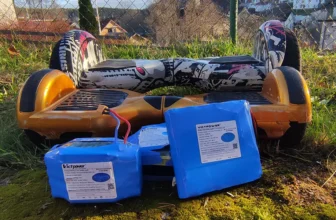There are two ways to test the condition of your hoverboard’s battery. The first is the more traditional way of using a voltmeter and the second method requires operating the hoverboard under controlled conditions to observe its behavior.
In this guide we will be covering everything from analyzing common signs of a failing/bad hoverboard battery, how you can test your current battery both with tools and without them. Once that’s done and we know the health of your hoverboard battery, you can click the link at the bottom to come to our hoverboard battery replacement guide.
Common Signs of A Faulty Hoverboard Battery
The first thing you start to notice as your battery deteriorates is that your hoverboards range/operating time starts to diminish. You’ll also notice a shorter charging time until the green light for a full charge .
Although slightly scarier, the second most common sign of a faulty hoverboard battery is often made very clear to the rider. The tell tale sign is that the hoverboard’s battery cuts its own power in the face of heightened resistance. After which you won’t be able to turn it on again without connecting it to a charger, or detaching and reattaching the battery.
Depending on how degenerated your battery is, these signs may only show themselves when the battery’s power is starting to run low or when the motors face strong resistance, like going up a hill. The BMS(Battery Management System) is built to protect the battery, and not the rider, so it can sometimes cause serious injury to the rider.
Step-by-Step: Testing Your Hoverboard Battery’s Condition
Testing Using a Voltmeter
Testing your battery using a voltmeter, even if you have little to no experience is super simple. Just follow our guide and compare your battery’s voltage to our chart at the end.
Tool Needed: Philips screwdriver, Voltmeter

How-to:
- Preparation: Charge your hoverboard fully then turn off your hoverboard and place it upside down on a stable surface.
- Locate the Battery: Identify the battery compartment on your hoverboard. This is on most models situated on the opposite side of the power button.
- Remove the Bottom Cover: Using a Philips screwdriver remove the screws holding the plastic cover in place.
- Remove Battery Connection: The battery is connected to the mainboard using an orange/yellow connector. Separate it gently using your hands.
- Set the Voltmeter: Switch your voltmeter to the DC voltage setting. Ensure the range is appropriate for your hoverboard’s battery. Typically hoverboard batteries operate at either 24V or 36V, the latter being the most common. Either read the label on your battery, or check the user manual.
- Probe Placement: Gently insert the positive (red) probe of the voltmeter onto the positive terminal of the battery. Simultaneously, place the negative (black) probe onto the negative terminal.
- Reading the Voltage: The voltmeter will display the current voltage of your hoverboard battery. Cross your readings with our battery health meter below to find out the condition of your battery pack.
- Interpreting the Results: If the voltage is significantly below the expected level(see your manual), it indicates a potential issue with the battery’s health. A drastic drop may point to a faulty cell or overall degradation and a replacement is needed.
- Recording and Documentation: Document the voltage reading for future reference. A decreasing voltage over time may suggest an aging battery.
- Closure: Safely disconnect the voltmeter, reconnect the connectors, and secure the battery compartment.
Remember, to not stress it as we are working with a live and hopefully healthy battery we do not want to accidentally short-circuit it. Now depending on your results you know that your battery is either healthy, or has defective/aging cells.
Battery Health Meter
| Battery Health | Voltage Range (24V) | Voltage Range (36V ) | Explanation |
|---|---|---|---|
| Healthy Battery | 27.0V – 28.0V | 41.5V – 42.0V | Battery is performing optimally with minimal wear. |
| Moderately Healthy | 25.0V – 26.9V | 39.5V – 41.4V | Signs of moderate wear; still functioning but with reduced performance. |
| Needs Replacement | < 25.0V | < 39.5V | Significant deterioration or imbalance detected, needs replacing. |
Testing Without Tools (Caution!)
- First make sure the hoverboard battery are low on charge.
- Then find a secure location where you can safely hold on to something to prevent you falling if the hoverboard shuts down without warning. I prefer a table where I can put half my body over the table.
- Now hold on tight to the corners of it and lean forward while pushing your feet backwards to not make the hoverboard move. This simulates the resistance you’d get from riding up a very steep hill.
If the results are that the hoverboard shuts off, then that is a clear sign your hoverboard battery has faulty cells, and needs to be replaced.
You Now Know the Status of Your Hoverboard Battery
There are two endings to this guide. Number 1 you have found that your battery is in good condition and you can continue to ride safely. If you are still experiencing issues with your hoverboard you will need to continue the troubleshooting. If you have any questions feel free to hit us up for some troubleshooting and repair advice if you need it!
Number 2 you have identified a faulty battery and you should not operate the hoverboard until the battery has been replaced. Feel free to jump over to our hoverboard battery replacement guide and we will walk you through the process of doing so. Depending on the overall health of your hoverboard, sometimes it doesn’t make financial sense to repair it. Then its better to find yourself a new more reliable model, if you want assistance with that we have done the legwork for you and created a great resources on the best hoverboard brands and models.







